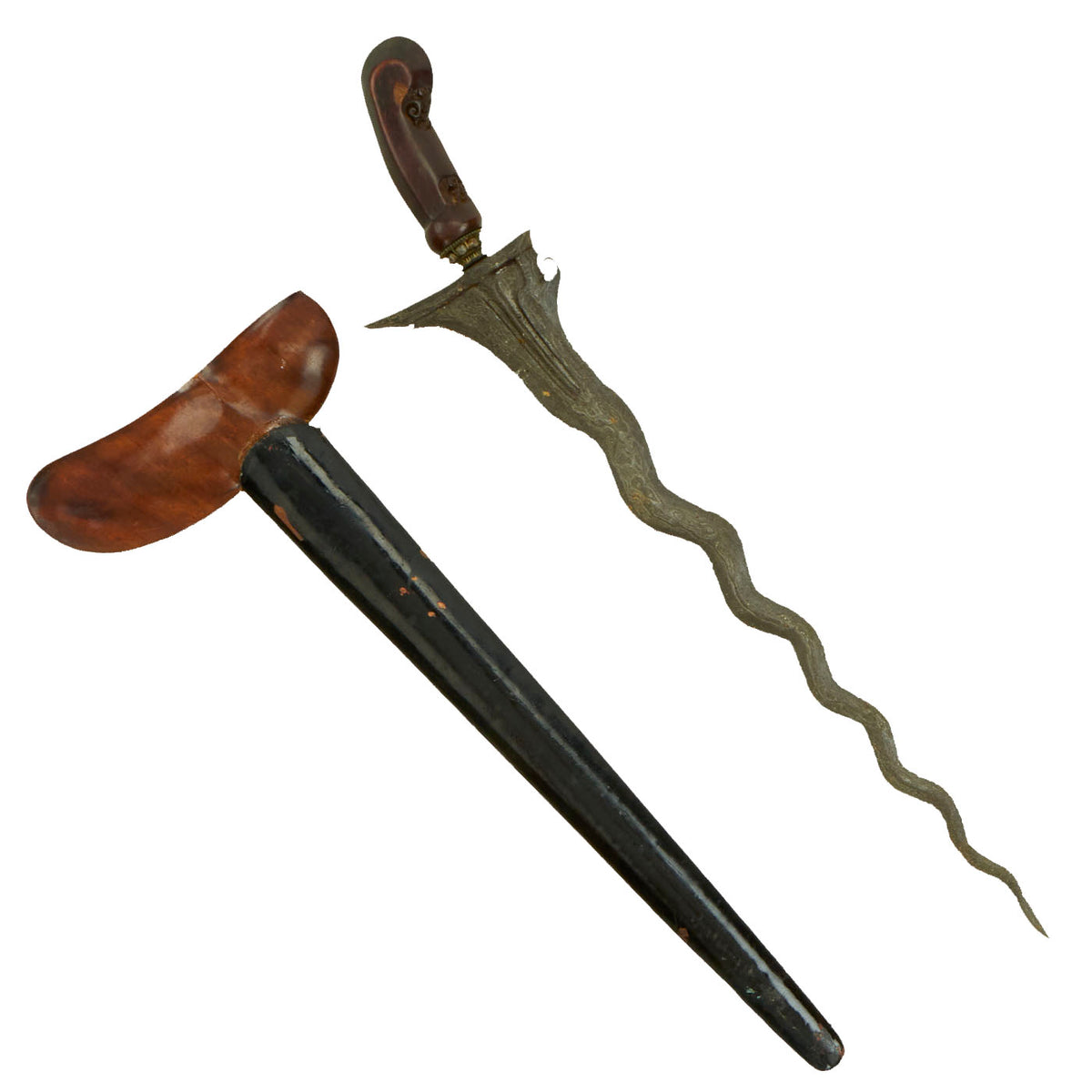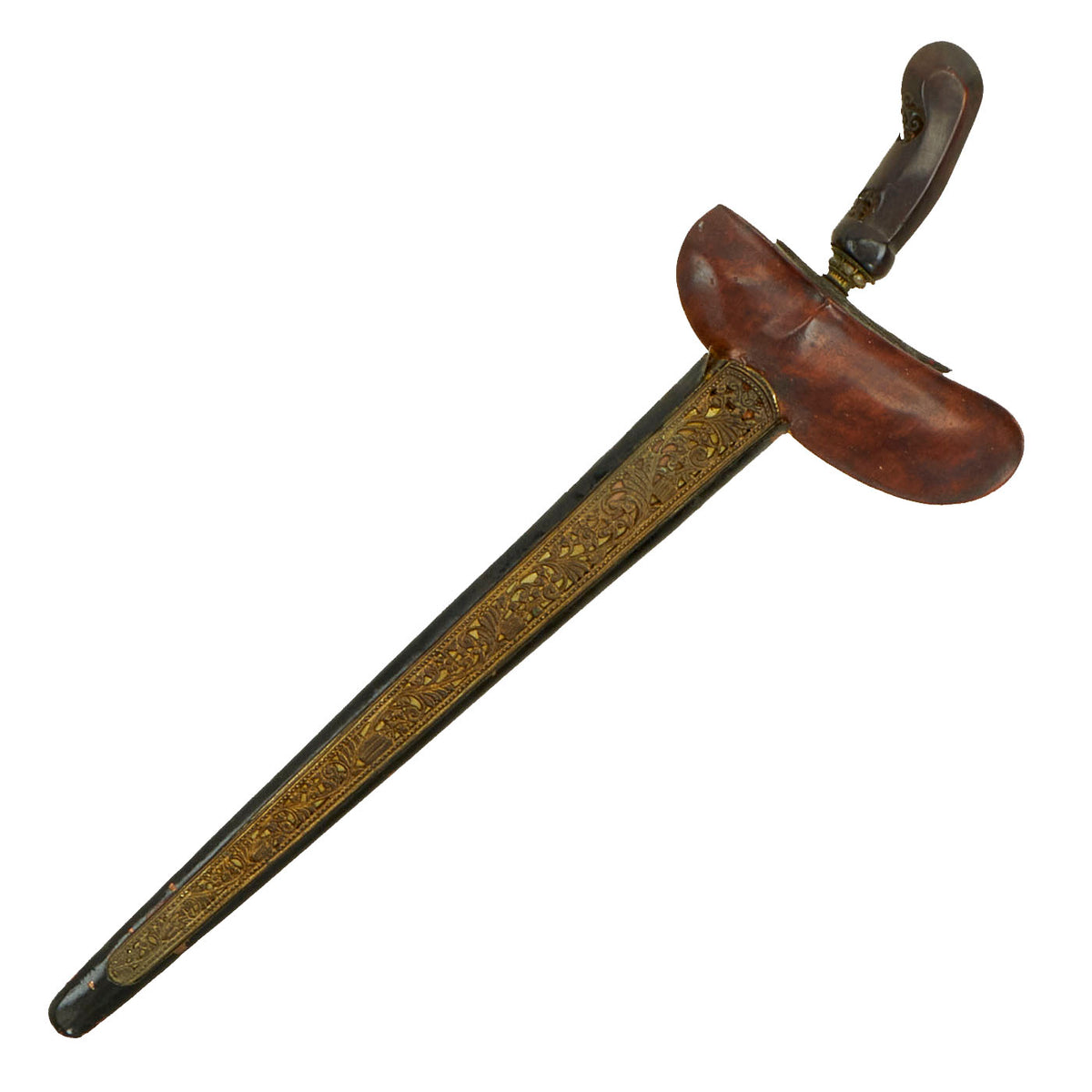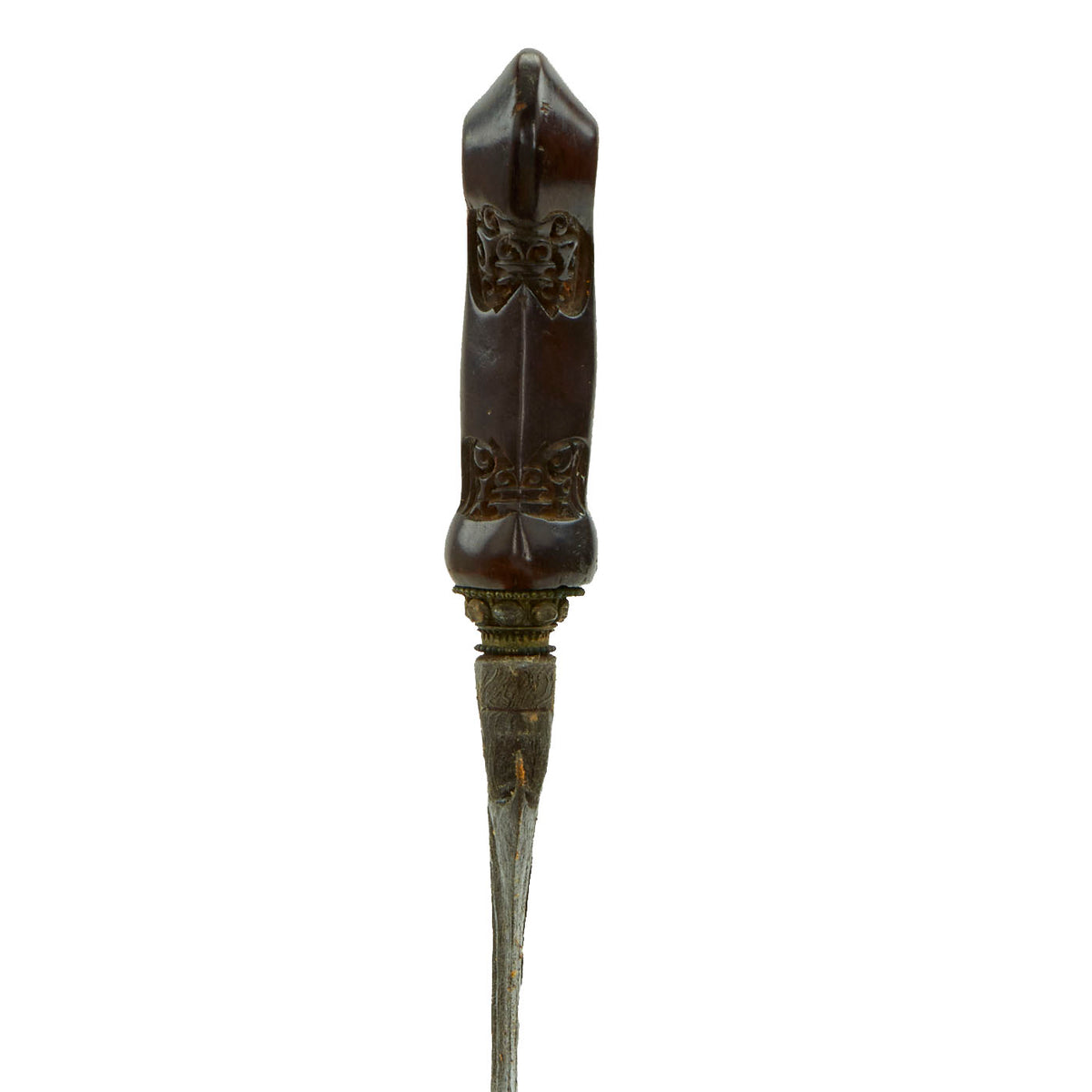Original Dutch East Indies Kris Dagger with Carved Handle in Scabbard from the Island of Sumatra – circa 1850 Original Items
$ 295,00 $ 118,00
Original Item: One Only. The kris or keris is a prized asymmetrical dagger most strongly associated with the culture of Indonesia, but also indigenous to Malaysia, Thailand, Brunei and Singapore. It is known as kalis in the southern Philippines. The kris is famous for its distinctive wavy blade.
A kris can be divided into three parts: bilah (blade), hulu (hilt), and warangka (sheath). These parts of the kris are objects of art, often carved in meticulous detail and made from various materials: metal, precious or rare types of wood, or gold or ivory. A kris’s aesthetic value covers the dhapur (the form and design of the blade, with around 150 variants), the pamor (the pattern of metal alloy decoration on the blade, with around 60 variants), and tangguh referring to the age and origin of a kris.
Both a weapon and spiritual object, kris are often considered to have an essence or presence, considered to possess magical powers, with some blades possessing good luck and others possessing bad. Kris are used for display, as talismans with magical powers, weapons, a sanctified heirloom (pusaka), auxiliary equipment for court soldiers, an accessory for ceremonial dress, an indicator of social status, a symbol of heroism, etc. Legendary kris that possess supernatural power and extraordinary ability were mentioned in traditional folktales, such as those of Mpu Gandring, Taming Sari, and Setan Kober.
This example is not a modern tourist item, it is the real thing dating from the 19th century. Many of these were brought home from the South East Pacific after WWII.
The key to identify the older blades is to be able to find the join at the hilt end of the blade as the horn was always added as a separate piece. Later examples and modern tourist pieces were always had blades made from just one sheet of steel. This example definitely has the separate hilt end of the blade, which is then brazed or welded on.
Each section of the Dutch East Indies produced the traditional Kris Daggers but each district, Java, Borneo, and others had their own characteristics. This area is today covered by what we know as Indonesia, Malaya and the Philippines.
The 14 inch blade on this example (17 1/2 inches overall) is made from high nickel content iron, often found in meteorite iron, giving a unique finish known as “pamor”. The iron was crucible forged, much like wootz steel, giving it a lovely laminated appearance on the straight blade. Kris daggers with this highly “wavy” curved ;blade are typical for the island of Sumatra.
The blade is mounted in a wooden carved hilt, which has two animal faces carved on one side. As is typical, the handle is overall “J” shaped, and has a cup-shaped engraved top fitting, ending in a filigreed brass ferrule set with semi-precious stones where it meets the blade.
This kris also comes complete with its original exotic wood scabbard (warangka), which is made of a lovely wood, and the lower part (galar) has an sheet copper cover (pendoq), which is painted black. On one side there is an ornate embossed brass section. Unfortunately, the top wood portion of the scabbard has broken off, and it looks like someone tried to reglue it at some point, but this failed, so it is currently only held in place by pressure.
A very nice example of a the legendary Kris dagger, ready to display!
Specifications:
Blade Length: 14″
Blade Style: Double Edged Wavy “Kris”
Overall length: 17 1/2“
Scabbard Length: 15″
Fast Shipping with Professional Packaging
Thanks to our longstanding association with UPS FedEx DHL, and other major international carriers, we are able to provide a range of shipping options. Our warehouse staff is expertly trained and will wrap your products according to our exact and precise specifications. Prior to shipping, your goods will be thoroughly examined and securely secured. We ship to thousands clients each day across multiple countries. This shows how we're dedicated to be the largest retailer on the internet. Warehouses and distribution centres can be located throughout Europe as well as the USA.
Note: Orders with more than one item will be assigned a processing date depending on the item.
Before shipping before shipping, we'll conduct a thorough inspection of the items you have ordered. Today, the majority of orders will be delivered within 48 hours. The delivery time will be between 3-7 days.
Returns
The stock is dynamic and we cannot completely manage it because multiple stakeholders are involved, including our factory and warehouse. So the actual stock may alter at any time. It's possible that you may not receive your order once the order has been made.
Our policy is valid for a period of 30 days. If you don't receive the product within 30 days, we are not able to issue a refund or an exchange.
You can only return an item if it is unused and in the same state as the day you received it. You must have the item in its original packaging.
Related products
Uncategorized
Uncategorized
Uncategorized
Uncategorized
Angolan Rebel 1970s era 60mm Inert Display Mortar from Angolan Civil War Original Items
Uncategorized
Uncategorized
Uncategorized
Uncategorized
Uncategorized
Australian WWII Owen MK1 Machine Carbine SMG Custom Fabricated Replica with Sling Original Items
Uncategorized
Armored Burgonet Helmet & Polearm from Scottish Castle Leith Hall Circa 1700 Original Items
Uncategorized
Armoured Fighting Vehicles of the World: AFVs of World War One (Hardcover Book) New Made Items
Uncategorized
Uncategorized
Uncategorized
Band of Brothers ORIGINAL GERMAN WWII Le. F.H. 18 10.5cm ARTILLERY PIECE Original Items
Uncategorized
Uncategorized
Uncategorized
Uncategorized












































































